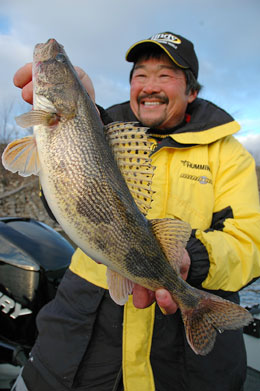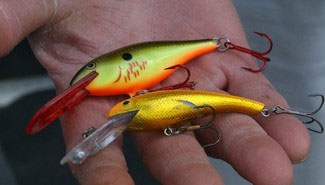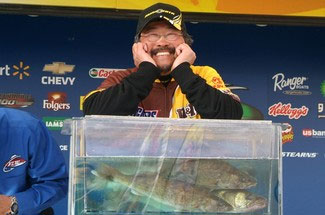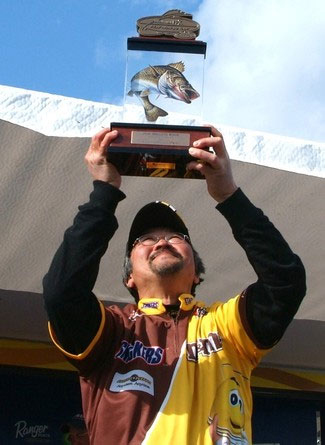Football players learn a lot by analyzing film from last Sunday’s game.
The same goes for professional fishermen. Taking a close look at the last tournament teaches them plenty about what works and what doesn’t. Reflection is valuable not only for people with money on the line, but also for the average angler who can learn a lot and improve their next time on the water.
 Take the FLW Walleye Tour event on the Mississippi River at Red Wing, Minn., in May, for example. (Ted won it with 93 pounds, 5 ounces for 20 fish over four days.) Looking back, the key was being savvy enough to find two separate patterns that consistently produced saugers and walleyes bigger than the Red Wing area has produced in years. Another was being versatile enough to capitalize on the opportunities. A third was having great onboard aids like state of the art sonar, a trolling motor with autopilot and a responsive boat that allowed precise boat control.
Take the FLW Walleye Tour event on the Mississippi River at Red Wing, Minn., in May, for example. (Ted won it with 93 pounds, 5 ounces for 20 fish over four days.) Looking back, the key was being savvy enough to find two separate patterns that consistently produced saugers and walleyes bigger than the Red Wing area has produced in years. Another was being versatile enough to capitalize on the opportunities. A third was having great onboard aids like state of the art sonar, a trolling motor with autopilot and a responsive boat that allowed precise boat control.
Scouting the playing field
Paying attention to detail during pre-fishing was essential to fine-tuning the strategy that led to victory. Identifying the locations and presentations that produce the most fish and the biggest fish in the shortest time is critical whether out for a fun day or with a clock counting down the time to weigh-in. But, as was the case on Mississippi River Pools 3-5, the tactic that produces the most fish isn’t always the one that produces the largest ones. The difference means money for pros. For weekend anglers, the difference allows them to choose what kind of day they want – lots of fish or a chance for a trophy.
The sauger and walleyes were well into a post-spawn mode, moving from the river into the deeper water offered in Lake

photo courtesy FLW OutdoorsPepin. River levels were also falling, which meant’ less current. Nice saugers in the 3 to 4 pound range were concentrated in areas adjacent to major points in the lake. Larger walleyes were relating to current areas at the head of the lake where the river comes into Lake Pepin and on the tips of the major points in the lake.
The advantage to focusing on those fish was they were willing to snap lures like #7 Shad Raps and #5 Wally Divers trolled on leadcore line.
The tournament was no-cull. Once a fish was put in the livewell, it stayed which meant’ that catching larger fish early was better than catching a bunch of fish. Each boat was allowed eight fish on board. The pro-am teams would weigh their biggest five each day. A faster presentation like trolling would let pros fill out a solid limit of five fish and still have the chance to upgrade three more.
A lesser-known pattern also was at work during pre-fishing. Nice-sized walleyes were taking a slower, more methodical approach of slow trolling Lindy Bottom Bouncers with four foot Lindy Rig snells with a #2 hook dressed with a half ‘crawler. Another key aspect to this rig was the addition of an orange Lindy snell float which kept the crawler slightly off bottom.
The strategy became clear. Use the faster approach to nail a limit of good saugers as fast as possible, then head to the big walleye spots.
The worm turns
Sometimes, the best laid plans actually do work – with modification.
FLW tournaments are set up so everyone fishes the first three days. Only the top 10 pros and top 10 co-anglers advance to the final day.

photo courtesy FLW OutdoorsEach day began the same – trolling leadcore line and crankbaits in search of a limit of decent 19 to 21 inch sauger in order to stay in the game near the top of the standings. Leadcore is very speed sensitive. The faster you go, the higher the lures run, the slower you go, the deeper. Success depends upon precise speed and depth adjustments to stay just 6 inches to a foot off the bottom where the fish are. Too fast, and you’re out of the strike zone. Too slow and the hooks are fouled with vegetation growing on the bottom.
The best boat control method proved to be using the 9.9hp Mercury Pro-kicker motor on the stern of the Lund 208 Pro-V GL to provide base forward trolling power. The Minn Kota Terrova trolling motor (with co-pilot) on the front fine-tuned the speed, which was best at 1.5 to 1.7 mph in current areas and 2.2 mph in the lake, and the boat turns quicker from the front. Using the bow mounted electric trolling motor also put a transducer in the water at the front of the boat where a rise or fall in the depth contour appeared sooner on the Humminbird sonar mounted on bow than it would have waiting for changes to appear on the sonar located on the console. As a result, speed and direction could be adjusted quickly. It was critical to stay right on the productive depth of 19 to 21 feet for saugers on the lake trolling spots. 10 to 14 feet depths were the ticket at places like Pig Point or the Red Cans area where the river channel meets the lake.
Everything went according to plan on Day One. A limit of saugers in the box by eleven o’clock gave Ted the flexibility to head to Pig Point near the head of the lake, which had produced fish up to 25 inches while trolling in practice.
Don’t you just love it when things work the way you want? A 28-inch walleye was caught within the first 15 minutes of trolling at Pig Point and put into the boat. With 8 fish in the livewell, Ted was done for the day by noon with a resulting 21.63 pound weight and an 8th place day one finish. Still, the weigh-in brought news that pro, Rick Zachowski, was almost 19 pounds ahead with an incredible 40-pound bag. Like playing golf against Tiger Wood, the rest of the field thought they were fishing for second place.
Never say die
Day Two was tougher. But, the trolling bite produced another decent limit of five fish by 1 p.m. Back to trolling Pig point produced another 28-inch fish and an identical 21.63 pound weight for Day Two. Ted had moved up 3 positions to 5th place.

photo courtesy FLW OutdoorsDay Three started out even tougher, maybe because the wind had died down. Only three saugers were in the box after trolling leadcore near three different spots on the lake. While trolling the 3rd spot, Ted noticed some big marks which appeared on his sonar on a sharp breakline near the tip of Central Point. With no fish trolling the first pass, he turned the boat around, put the bottom bouncers down to 30 feet where he had marked the fish and, “Bam!” The first fish was a 30-inch monster weighing 11 pounds. Not long after, a 27-inch walleye was in the net. Then, a 4-pound eye. The day produced over 29 pounds and in first place, leading with a solid 7½ pound advantage going into the final day four.
The strategy for Day Four was to get 15 to 20 pounds. With 15 to 20 pounds, even second place would have to have a great day to overcome the 7½ pound deficit. Trolling was slow. Four fish by noon. But, the rigging bite on the big-fish spot from the previous day secured the victory. It produced a 7 pounder and a 4 pounder in time to make the weigh-in. The 20-pound, 11-ounce limit in the box brought the final total to 93 pounds, 5 ounces. The nearest competitor was Nick Johnson with 78 pounds, 12 ounces.
As Ted told the FLW audience, “I really had a good game plan, precise boat control, and was confident in my ability to both rig and troll – to be versatile.” This is a good lesson for anyone who wishes to become a better angler.










